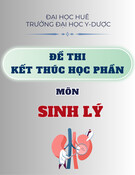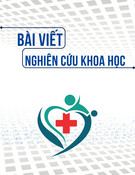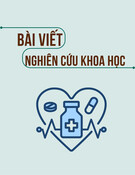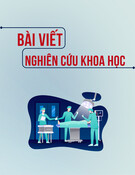
JOURNAL OF 108 - CLINICAL MEDICINE AND PHARMACY Vol. 19 - Dec./2024 DOI: https://doi.org/10.52389/ydls.v19ita.2524
110
Outcomes of episiotomy and perineorrhaphy in vaginal
delivery at the National Hospital of Obstetrics and
Gynecology
Vu Chunh¹, Nguyen Duc Anh
1
Dang Thi Minh Nguyet2 and Dao Thi Hoa2*
1Hanoi Medical University,
2National Hospital of Obstetrics and Gynecolog
y
Summary
Objective: To evaluate the outcomes of episiotomy and perineal suturing in vaginal delivery at the
Obstetrics and Gynecology Hospital. Subject and method: This is a prospective descriptive study
involving all vaginal delivery patients who underwent episiotomy and perineal suturing at the National
Hospital of Obstetrics and Gynecology from November 1, 2023 to December 31, 2023. Result: A total of
384 women were included in the study, with an average age of 28.32 ± 5.12 years (the youngest being
15 years and the oldest 42 years. The age under 35 years accounted for the majority of 88.3%. The
proportion of primiparous was 55.73%, while 44.27% were multiparous. The incidence of mothers with
diabetes was the highest, accounting for 13.5% of the total study population. The indication for perineal
incision was predominantly maternal, accounting for 88.52%. There were 15 cases with a third-degree
perineal tear, accounting for 3.90%. Of these, the rate of injury after forceps delivery was 100%. There
were 4 cases of hematoma and 1 case of infection post-episiotomy. The rate of third-degree perineal
injury when fetal weight was >3500g and BPD > 95mm were 31.2% and 73%, respectively. Conclusion:
Episiotomy and perineorrhaphy remain common procedures in vaginal deliveries in Vietnam. Most cases
do not result in complications, and the perineum typically tears only to a physiological degree,
specifically to degree II, with a low rate of complex tearing. Our study indicates that forceps delivery
increases the risk of more severe perineal injuries. Moreover, third-degree tears are associated with
infants weighing over 3500grams and BPD more than 95mm.
Keywords: Episiotomy, perineorrhaphy, vaginal delivery.
I. BACKGROUND
Episiotomy and perineorrhaphy is a surgical
procedure performed at the perineum and posterior
vaginal wall during the second stage of labor1. When
there are risks of excessive stretching, the vulva and
perineum may sustain uncontrolled tears, even
extensive tearing that can damage the surrounding
muscles. To minimize such injuries, in necessary
cases aimed at widening the soft tissues of the birth
canal, obstetricians or midwives may proactively
Received: 24 October 2024, Accepted: 26 November 2024
*Corresponding author: drdaothihoapstw@gmail.com -
National Hospital of Obstetrics and Gynecology
perform a perineal incision during the delivery stage
to facilitate the process, allowing for easier fetal
descent, reducing trauma to the fetal head, and
avoiding the risks of complex perineal tears2.
Despite the clear benefits, this procedure also
has some disadvantages and side effects for the
mother, including prolonged pain and edema at the
suture site after the postpartum period, hematoma
leading to an increased risk of infection at the suture
site, greater blood loss in mothers undergoing the
procedure, and other complications arising from
incorrect timing and technique of the incision and
suturing3.

JOURNAL OF 108 - CLINICAL MEDICINE AND PHARMACY Vol. 19 - Dec./2024 DOI: https://doi.org/10.52389/ydls.v19ita.2524
111
Currently, there are numerous research studies
worldwide on this topic, and the rate of episiotomy
is showing a significant downward trend. In the
United States, from 2000 to 2003, the episiotomy
rate was 35%, which dropped to 15% by 20114. In
France, from 2013 to 2017, the rate of episiotomy
decreased from 21.6% to 14.3% for all vaginal
deliveries5.
In Vietnam, episiotomy is considered a routine
obstetric procedure in hospitals and medical
facilities. According to author Nguyen Tuan Viet at
the National Obstetrics and Gynecology Hospital
(2015), this rate was 92%6. However, there are
currently not many research studies in Vietnam on
the benefits or harms of episiotomy.
The National Hospital of Obstetrics and
Gynecology is currently the leading maternity and
gynecology hospital in the country, especially in
Northern Vietnam. Each year, the hospital provides
medical examinations and delivery services for
thousands of pregnant women in Hanoi and
surrounding areas. Therefore, we conducted the
study titled “Outcomes of episiotomy and
perineorrhaphy in vaginal delivery at the National
Hospital of Obstetrics and Gynecology.
II. SUBJECT AND METHOD
2.1. Subject
Pregnant women who deliver via vaginal birth
at the National Hospital of Obstetrics and
Gynecology.
Gestational age of at least 34 weeks, as
determined by the first-trimester ultrasound.
Live fetus without congenital anomalies.
Fetal weight over 2000 grams.
Pregnant women who underwent episiotomy
and perineorrhaphy.
Exclusion criteria:
Women with abnormal pregnancies.
Incomplete medical records.
Patients who refused to participate.
Study design: This is a prospective descriptive
study conducted on women who delivered vaginally
at the National Hospital of Obstetrics and
Gynecology and met the inclusion criteria.
Sample size:
The sample size for a cross-sectional descriptive
study is calculated using the following formula:
Where:
n: Minimum required sample size.
Z: Z-score for a 95% confidence level, Z1-α/2 =
1.96.
p: Episiotomy rate at the National Hospital of
Obstetrics and Gynecology, reported as 92% in 2016
by Nguyen Tuan Viet, so p=0.92.
Desired precision, d=0.05.
Substituting into the formula:
n= (1.962 )x 0.92 x 0.15/0;052 = 212
To align with the number of deliveries at the
National Hospital of Obstetrics and Gynecology
during the study period and to improve
representativeness, we chose a sample size of 400
participants.
Research content and indicators:
Patient characteristics in the study group:
Age.
Height.
Parity (number of deliveries).
Maternal medical conditions.
Pregnancy outcomes:
Indication for episiotomy.
Newborn weight at birth.
Biparietal diameter.
APGAR score after birth.
Degree of perineal injury.
Uterine management.
Postpartum complications.
Study period: From November 1, 2023, to
December 31, 2023.
Study location: Delivery Department, National
Hospital of Obstetrics and Gynecology.

JOURNAL OF 108 - CLINICAL MEDICINE AND PHARMACY Vol. 19 - Dec./2024 DOI: https://doi.org/10.52389/ydls.v19ita.2524
112
Collection Method: Data is collected through
observation and information from medical records.
Create research records based on the research
objectives and the variables being studied.
Selecting the pregnant women who meet the
inclusion criteria for the study.
Observe the labor process and perineal incision.
Evaluate the outcomes post-episiotomy and
perineorrhaphy.
Collecting information according to a
predefined template.
Processing and analyzing the data.
Data processing and analysis: Collected data will
be entered and processed on SPSS 20.0 software.
Research ethics: The study was approved by the
Ethics Committee of the National Hospital of
Obstetrics and Gynecology, approval number 3099,
dated August 16, 2023.
III. RESULT
Table 1. Episiotomy rate of vaginal delivery
Total Percentage (%)
Episiotomy 384 96
Without episiotomy 16 4
Total 400 100
Comments: In our study, the episiotomy rate
was 96%.
Table 2. Patient characteristics
Characteristics Group Number Percentage (%)
Age
<35 339 88.3
≥35 45 11.7
Total 384 100
Height (cm)
<150 35 9.1
≥150 349 90.89
Total 384 100
Parity
Primiparous 214 55.73
Multiparous 170 44.27
Total 384 100
Maternal diseases
Diabetes 52 13.5
Hypertension 12 3.1
Cardiovascular diseases 3 0.78
Comments: A total of 384 subjects were included in the study, with an average age of 28.32 ± 5.12 years
(the youngest being 15 years old and the oldest 42 years old). The age group under 35 accounted for the
majority at 88.3%. The percentage of primiparous and multiparous were 55.73% and 44.27%, respectively.
Mothers with diabetes accounted for a significant proportion, with 52 cases, representing 13.5% of the total
study subjects.
Table 3. Pregnancy outcomes
Characteristics Group n Percentage (%)
Episiotomy indication
Maternal 328 85.42
Fetal 53 13.8
Procedure 3 0.8

JOURNAL OF 108 - CLINICAL MEDICINE AND PHARMACY Vol. 19 - Dec./2024 DOI: https://doi.org/10.52389/ydls.v19ita.2524
113
Characteristics Group n Percentage (%)
Fetal weight <3500g 352 91.7
≥3500g 32 8.3
BPD <95mm 369 96.1
≥95mm 15 3.9
Apgar score 4-7 4 1.05
8-10 380 98.95
Perineal tear severity Third degree 15 3.90
Uterine control Yes 228 59.38
No 156 40.62
Post-episiotomy
complications
Hematoma 4 1.04
Infection 1 0.26
Comments: In the 384 cases indicated for episiotomy, maternal-related accounted for 88.52%. Third-
degree tears occurred in 3.90% of cases, particularly in forceps-assisted deliveries. There were 4 cases of
hematoma and 1 case of infection post-episiotomy.
Table 4. Association between pregnancy outcomes and degree of perineal injury
Perineal tear
classification
Second-degree tear Third-degree tear p
n, % n, %
Indication
Due to maternal 328 (100%) 0 (0%)
Due to fetal 41 (77.36%) 12 (22.64%)
Due to forceps 0 (0%) 3 (100%)
Birth weight
< 3500g 350 (99.4%) 2 (0.6%) <0.01
≥ 3500g 22 (68.8%) 10 (31.2%)
Biparietal diameter
< 95mm 368 (99.7%) 1 (0.3%) <0.01
≥ 95mm 4 (26.7%) 11 (73%)
Total 372 (96.9% 12 (3.1%)
Comments: The results in Table 3 indicate that
the rate of third-degree tears occurred after forceps
delivery was 100%, due to fetal was 22.64%. The
incidence of third-degree tears occurred in infants
with a birth weight > 3500g and a biparietal
diameter (BPD) > 95mm were 31.2% and 73%,
respectively.
IV. DISCUSSION
4.1. Episiotomy rate of vaginal deliveries
Our study involved a total of 400 participants,
among which 384 women underwent episiotomy.
Based on the study objectives and selection criteria,

JOURNAL OF 108 - CLINICAL MEDICINE AND PHARMACY Vol. 19 - Dec./2024 DOI: https://doi.org/10.52389/ydls.v19ita.2524
114
we focused on the 384 women who received
episiotomy for the study.
Among the 400 women who delivered at the
National Maternity Hospital, the episiotomy rate was
96%. This indicates that Vietnam has one of the
highest episiotomy rates globally and within Asia.
This result is comparable to other Asian countries
such as Hong Kong (78-92.7%)7, Taiwan (100%)8, and
Cambodia (94.5%)9. However, this rate is
significantly higher than in some other countries,
including the United States (63%)10, China (45%),
France (44.7%)5, and is lowest in Sweden (9.7%).
Differences in episiotomy rates between countries
may result from variations in women's physical
conditions, health status, medical perspectives, and
healthcare consultation systems specific to each
country.
According to a study by Chuilon AL et al. (2010)
in France, the episiotomy rate among women of
Asian descent was significantly higher compared to
women of other ethnic backgrounds11.
This result aligns with the findings of Nguyen
Tuan Viet (2016) at the National Maternity Hospital,
where the episiotomy rate was 92%6. This may be
attributed to Vietnamese women's generally smaller
physique compared to women in other countries.
With better nutrition and prenatal care, fetal weights
tend to be larger, leading doctors and midwives to
prefer episiotomy to facilitate delivery and prevent
complications for both the mother and the baby.
With proper skills and technique, episiotomy, when
indicated and well-timed, has shown to yield good
outcomes, resulting in better stitching quality and
fewer complications. This may explain the high
episiotomy rate at the National Maternity Hospital
and other hospitals across Vietnam.
4.2. Characteristics of patients
The age range of the study participants is from
15 to 42 years, with an average age of 28.32 ± 5.13
years. Among them, the group of patients under 35
years old represents the highest proportion at
88.30%. Except for the case of a 15-year-old mother,
this is the reproductive age group consistent with
recommendations from reproductive health
organizations worldwide, including Vietnam.
According to a report by Shmueli12 in the European
Journal of Obstetrics and Gynecology, younger or
older mothers tend to experience more complex
perineal tears due to less elasticity in the pelvic floor
muscles. Therefore, older or very young mothers,
especially older primiparas, require careful and
precise perineal incision and suturing to avoid
complex tearing complications.
In the study group, 90.89% of women had a
height above 155cm. Height is an indirect measure
of pelvic size, which is important in determining the
method of delivery. Research by Vasanthi
Balamurugan (2020)9 indicates that shorter women
(usually under 150cm) have a higher risk of
complications, including higher rates of cesarean
sections, particularly in emergencies due to stalled
labor or fetal distress. However, maternal height is
not an independent risk factor but should be
considered alongside other factors such as age and
BMI. In addition, these factors only affecting overall
labor prognosis but not perineal incision and
suturing.
In Table 1, the rate of primiparas is 55.73%,
while multiparas account for 44.73%. This aligns
with findings by Nguyen Tuan Viet (2015)6, which
reported 56.09% for primiparas and 43.91% for
multiparas. This suggests that primiparas' perineum
has not yet adequately stretched, and perineal
incision is aimed at protecting soft tissues and pelvic
floor muscles from uncontrolled complex tears.
Among the 384 patients, comorbidities were
most common in mothers, particularly diabetes
mellitus at 13%, followed by hypertension and
cardiovascular diseases. According to research by
Mayer R. and Levin G. (2022)13, comorbidities during
pregnancy (diabetes and hypertension) are risk
factors for anal sphincter injury during childbirth.
4.3. Pregnancy outcomes
Regarding the pregnancy outcomes of the
women included in the study, the majority of
indications for episiotomy were maternal-related at
87.24%, followed by fetal-related causes at 11.98%,
and procedural reasons at 0.8%. Concerning birth






















![Bài giảng Cập nhật vấn đề hồi sức bệnh tay chân miệng nặng [mới nhất]](https://cdn.tailieu.vn/images/document/thumbnail/2025/20250920/hmn03091998@gmail.com/135x160/23301758514697.jpg)



